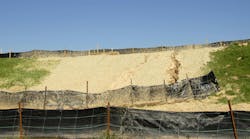AEM shares construction equipment market outlook for 2023
The Association of Equipment Manufacturers (AEM) says that the equipment manufacturing industry is still recovering from the impacts of the COVID-19 pandemic nearly three years after its onset, according to its equipment market outlook surveys.
AEM regularly surveys its members regarding their thoughts on various economic trends and how they are affecting their efforts to do business, both within the United States and abroad. In the latest survey, most respondents stated that they are still experiencing supply chain issues, with many saying that conditions continue to worsen.
“Nearly all respondents still face supply chain issues with more than half experiencing continuously worsening supply chain conditions,” said Kip Eideberg, senior vice president of government and industry relations at AEM during the association’s recently held quarterly Equipment Market Outlook Webinar. “The two driving factors that we hear are the current supply chain disruptions and the workforce shortages.”
The information obtained through the association's surveys is just some of what is detailed in AEM's Business Intelligence Dashboard and then later summarized in AEM’s quarterly Equipment Market Outlook Webinars.
The ongoing challenges of high interest rates, as well as energy and material prices, have plagued the construction industry.
Here are some of the driving forces and key points from AEM’s Q1 webinar regarding what equipment manufacturers in the construction industry will be facing for the remainder of this year, according to presenter Danny Richards, lead economist of construction at Global Data:
- Global construction output growth slowed in 2022 and is to remain sluggish in 2023. Interest rates remain high and could rise further in the first half of this year before central banks bring to an end this tightening cycle, assuming of course that inflation starts to fall. Energy and construction material prices also remain high, although some have fallen from the peaks of the second quarter of last year.
- Investment in infrastructure, as well as in energy and utilities, will be driving forces for growth. Investment in infrastructure will continue to be a driving force for growth, especially as the Investment Infrastructure and Jobs Act in the U.S. gathers momentum. Energy and utilities will also provide a boost to overall construction activity, with renewable energy projects remaining a key investment focus.
- The industry is optimistic as it tracks $3.6 billion in projects across multiple sectors. Despite a relatively weak short-term outlook for construction output, there is still a sizeable pipeline of opportunities on the horizon over the next several years.
- The decline in construction output is expected to slow in 2023. The U.S. was one of the few markets to register positive growth in 2020 and 2021. However, driven largely by intense inflationary pressure and a slowing residential sector, output dropped sharply in 2022. Despite the deeper-than-expected decline in the residential market remaining a risk to overall growth, there has been an improvement in non-residential sectors.
Despite supply chain and workforce retention issues, many equipment manufacturers are hopeful for eventual resolutions to these ongoing issues plaguing the industry.
AEM is a North America-based international trade group representing off-road equipment manufacturers and suppliers with more than 1,000 companies and more than 200 product lines in the agriculture and construction-related industry sectors worldwide.


